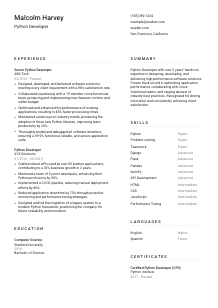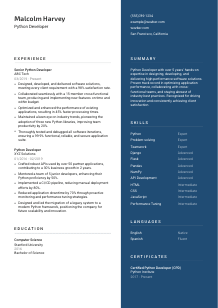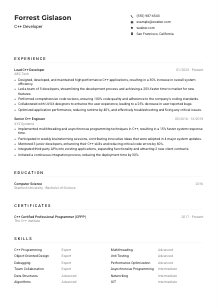Python Developer Resume Example
Crafting code, but your resume doesn't compile? Delve into this Python Developer resume example, optimized using Wozber free resume builder. See how seamlessly you can script your software skills to sync with job demands, ensuring your career path is as smooth as a well-indented block!

How to write a Python Developer resume?
Embarking on your journey to become a beacon of Python development? Crafting a resume that resonates with the specifics of your dream Python Developer role is paramount. In the sea of competitiveness, standing out requires more than just listing your experiences; it demands a narrative that aligns perfectly with what employers seek.
Leveraging Wozber's free resume builder, we'll navigate through the art of creating a resume that not only matches the job description but does so in an ATS-friendly manner. Let's decode the ins and outs of creating a Python Developer resume that locks in interviews.
Personal Details
The Personal Details section of your resume is your digital handshake. It's the segue into your professional story, making precision and relevance here non-negotiable. Here's how to tailor this section specifically for a Python Developer role, ensuring you capture the attention of hiring managers from the get-go.
1. Brand Yourself With Your Name
Your name is your headline. Ensure it's prominently placed, inviting the hiring manager into your professional world. A clear, bold font here is key, setting the stage for the details that follow.
2. Align Your Title With Your Dream Role
Position yourself strategically by mirroring the job title from the description. Placing "Python Developer" directly beneath your name aligns your profile with the role at first glance, crisply indicating your career focus.
3. Essential Contact Information
Streamline your contact details to include only the essentials - a reliable phone number and a professional email address. A pro tip: format your email as firstname.lastname@email.com to keep it professional and straightforward.
4. Address The Location Requirement
"Must be located in San Francisco, CA" - if this is you, make it known immediately. By listing "San Francisco, California" as your location, you're ticking off a critical requirement smoothly.
5. Professional Profile or Portfolio
If you have a GitHub repository showcasing your Python projects, include it. This provides a tangible display of your skills and projects, enriching your application with proof of your proficiency and dedication.
Takeaway
Perfecting the Personal Details section sets a professional tone for your resume. It's more than information; it's the initial pitch of your brand. Ensure it's polished, precise, and tailored, paving the way for a memorable first impression.





Experience
The Experience section is your career narrative, showcasing not just where you've been, but how you've made an impact. For Python Developers, this is your stage to shine by tailoring each entry to mirror the job's requirements. Let's dive into making your experience genuinely resonate with your Python Developer aspirations.
- Designed, developed, and delivered software solutions, meeting every client requirement with a 98% satisfaction rate.
- Collaborated seamlessly with a 15‑member cross‑functional team, producing and implementing new features on‑time and within budget.
- Optimized and enhanced the performance of existing applications, resulting in 45% faster processing times.
- Maintained a keen eye on industry trends, pioneering the adoption of three new Python libraries, improving team productivity by 20%.
- Thoroughly tested and debugged all software iterations, ensuring a 99.9% functional, reliable, and secure application suite.
- Crafted robust APIs used by over 50 partner applications, contributing to a 30% business growth in 2 years.
- Mentored a team of 5 junior developers, enhancing their Python proficiency by 50%.
- Implemented a CI/CD pipeline, reducing manual deployment efforts by 80%.
- Reduced application downtime by 70% through proactive monitoring and performance tuning strategies.
- Designed and led the migration of a legacy system to a modern Python framework, positioning the company for future scalability and innovation.
1. Decode the Job Description
Begin by dissecting the job description, pinpointing keywords and phrases like "hands-on experience in Python development" or "collaborate with cross-functional teams." These are golden clues to what the company values in a candidate.
2. Structure Your Roles Strategically
Present your experiences in a reverse chronological format, making your latest (and likely most relevant) role the first to catch the hiring manager's eye. Detailed, targeted accomplishment statements here are your best friends.
3. Showcase Your Impact
For each role, frame your contributions with the job description in mind. Did you "design, develop, and deliver software solutions in Python meeting every client requirement with a 98% satisfaction rate"? Such achievements speak directly to what hiring managers are looking for.
4. Quantify Your Success
Whenever possible, add numbers to your achievements. This might look like "Optimized and enhanced application performance, resulting in 45% faster processing times." Numbers make your impact tangible and memorable.
5. Relevance is Key
Tailor each experience to reflect your expertise in Python development. Every bullet point should echo your proficiency in the required skills, be it through your proficiency in frameworks like Django or your knack for collaboration.
Takeaway
An Experience section meticulously aligned with the job description acts as a beacon, signaling to hiring managers that you're not just a fit—you're the right candidate. Make your narrative compelling, impactful, and, above all, relevant.
Education
While straightforward at its core, the Education section can significantly bolster your candidacy, especially when tailored to reflect the requirements of your Python Developer role. Let's explore how to fine-tune this section to highlight the foundation of your expertise.
1. Identify Key Requirements
"Bachelor's degree in Computer Science, Information Systems, or a related field." - Match the job's educational requirements with your credentials, right off the bat. This establishes a baseline of your qualification.
2. Keep It Simple and Structured
Present your educational background straightforwardly: your degree, the field of study, the institution, and your graduation year. Clarity here allows the hiring manager to swiftly assess your educational credentials.
3. Degree Alignment
If you have the exact degree listed in the job description, such as a "Bachelor of Science in Computer Science," make sure it's clearly stated. This directly ties your academic background to the role's requirements.
4. Highlight Pertinent Courses
For roles as specific as Python Developer, listing key courses related to programming and software development can add layers to your qualifications, especially if you're in the early stages of your career.
5. Showcase Additional Academic Achievements
If you've engaged in noteworthy projects or thesis work relevant to Python development, don't hesitate to include these details. This can demonstrate initiative and a deeper engagement with your field of study.
Takeaway
Tailoring your Education section to mirror the job requirements bridges your academic achievements with the role you're aiming for. It's more than a list; it's an assurance of your foundational expertise. Highlight with purpose, and let your educational background underscore your candidacy.
Certificates
In the constantly evolving field of Python development, certifications can significantly bolster your credibility. While the job description may not always specify them, astutely chosen certifications reflect your commitment to staying at the forefront. Let's strategize the best approach to curating this section.
1. Key Job Requirements
Although the job description for the Python Developer role may not explicitly list required certifications, aligning your listed certifications with the skills sought (e.g., a "Certified Python Developer" credential) can set you apart.
2. Selective Listing
Curate your certificates to prioritize those most relevant to Python development. This means listing those that affirm your expertise in Python, its frameworks, or any other skills highlighted in the job description.
3. Date Transparency
Featuring the acquisition date of your certificates, especially if they are recently earned, paints you as an actively growing professional, keeping abreast of the latest in Python development.
4. Continuous Learning
The tech field is dynamic, and so should be your learning curve. Emphasize ongoing or recent certification endeavors to showcase your commitment to professional growth and staying relevant.
Takeaway
Certificates are your professional badges of honor in the Python development arena. Choose wisely and update regularly, letting them serve not just as decorations, but as compelling evidence of your skills and dedication to your craft.
Skills
A well-crafted Skills section is akin to the toolbox every employer hopes you bring to the Python Developer role. By aligning this section with the job's explicit and implied requirements, you invite an immediate connection with what the role demands. Let's pinpoint how to effectively showcase your skill set.
1. Unpack the Job Description
Extract from the job description both the stated and the 'between-the-lines' skills, such as proficiency in Python frameworks like Django or Flask, and softer skills like problem-solving and teamwork.
2. Direct Alignment
List skills that mirror the job requirements, classifying them into technical skills (e.g., Django, Flask) and soft skills (e.g., teamwork, problem-solving). This showcases a well-rounded candidacy.
3. Organized Presentation
Keep this section crisp and prioritized, focusing on the skills most relevant to the job description. This isn't the place for a laundry list but rather a curated selection that speaks directly to the Python Developer role.
Takeaway
Skillfully presenting your skills section can greatly amplify your resume's resonance with the targeted Python Developer role. Each listed skill is a testament to your suitability and readiness for the challenges ahead. Make them count.
Languages
In an increasingly globalized work environment, your linguistic capabilities can add an unexpected edge to your Python Developer application. While the primary focus might be on technical skills, don't overlook the value of showcasing your language proficiencies.
1. Job Specification
Spot any language requirements or preferences stated in the job description, such as "Strong English fluency is essential for this role," and ensure these are prominently listed in your resume.
2. Prioritize Essential Languages
Highlight the languages critical to the job at the top of your Languages section, marking your proficiency level clearly to avoid ambiguity.
3. Additional Languages
Even if not directly related to the job, other language skills can illustrate your adaptability and global mindset, subtly boosting your candidacy.
4. Honesty in Proficiency
Clearly label your proficiency levels (native, fluent, intermediate, basic) to set realistic expectations about your communication capabilities in additional languages.
5. Consider the Role's Scope
For Python Developer roles with a potential global or diverse team interaction, highlighting multiple language proficiencies can underscore your value as a communicator and team player.
Takeaway
In our connected world, every language you speak is a bridge to new opportunities and collaborations. While your technical prowess gets you in the door, your linguistic skills could very well be the unique trait that seals the deal. Embrace your global citizenry with pride.
Summary
At the heart of your resume, the Summary section encapsulates your professional identity. For a Python Developer, this is where you distill your experiences, skills, and aspirations into a potent introduction that captures and retains the hiring manager's attention. Let's refine this narrative to ensure it's both compelling and reflective of the role you're targeting.
1. Capture the Job's Essence
Start by absorbing the core requirements and desired qualities listed in the job description. This understanding will guide the tone and content of your summary, ensuring relevance.
2. Lead With Your Professional Identity
Introduce yourself as a Python Developer, anchoring your summary in the reality of your experiences and the depth of your expertise in the field.
3. Address the Role's Key Needs
Mention your mastery in Python, your proficiency with frameworks like Django and Flask, and highlight achievements that align with the role's responsibilities, such as software development and collaborative project successes.
4. Conciseness is Might
Your summary should be a high-impact, succinct narrative. Aim for 3-5 sentences that capture the essence of your professional journey, tailored to the narrative that you are the optimal candidate for the Python Developer position.
Takeaway
Your summary isn't just an opening statement; it's your pitch, your banner that announces your candidacy with confidence and clarity. Craft it with care, align it with the job's requirements, and let it be the hook that captivates from the very start. Embark on this journey with your head held high, knowing you're presenting a narrative woven with the threads of your unique experiences, skills, and aspirations. The right opportunity awaits, and your tailored resume is the key that unlocks the door.
Launching Your Python Developer Journey
Congratulations on taking a significant stride towards your goal. Armed with these tailored strategies and the assistance of Wozber's free resume builder, including ATS-friendly resume templates and an ATS resume scanner for optimization, your Python Developer resume is now poised for greatness. Remember, your resume is more than a document; it's a narrative, a dialogue with potential employers that starts with "Hello, here I am" and leads to "Let's explore what we can achieve together." Write it with intention, refine it with care, and launch it with confidence.
The path to your next big role is clearer than ever. Go forth, make your mark, and let the world see the brilliance of your code and character.

- Bachelor's degree in Computer Science, Information Systems, or a related field.
- Minimum 3 years of hands-on experience in Python development.
- Proficiency with popular Python frameworks (such as Django or Flask) and libraries (such as Pandas or NumPy).
- Familiarity with front-end technologies including HTML, CSS, and JavaScript.
- Strong problem-solving skills and the ability to work in a collaborative team environment.
- Strong English fluency is essential for this role.
- Must be located in San Francisco, CA.
- Design, develop, and deliver software solutions in Python to meet client requirements.
- Collaborate with cross-functional teams to define, design, and ship new features.
- Maintain and improve the performance of existing applications and ensure they are scalable.
- Stay updated with the latest industry trends and best practices in Python development.
- Conduct thorough testing and debugging to ensure the functionality, reliability, and security of the company's software.















